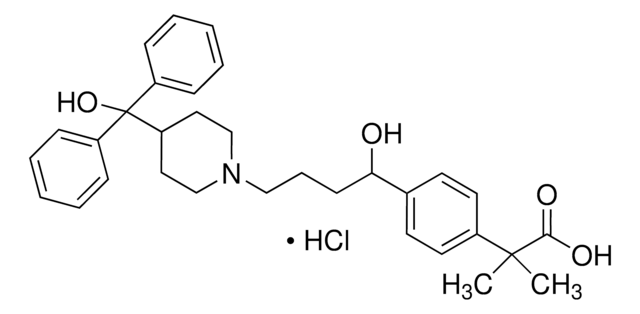1492007
USP
Palmitic acid
United States Pharmacopeia (USP) Reference Standard
Synonym(s):
1-Pentadecanecarboxylic acid, C16:0, Cetylic acid, Hexadecanoic acid, NSC 5030, PamOH
About This Item
Recommended Products
grade
pharmaceutical primary standard
vapor pressure
10 mmHg ( 210 °C)
API family
palmitic acid
manufacturer/tradename
USP
bp
271.5 °C/100 mmHg (lit.)
mp
61-62.5 °C (lit.)
solubility
water: 0.00005 g/L at 20 °C
density
0.852 g/mL at 25 °C (lit.)
application(s)
pharmaceutical (small molecule)
format
neat
storage temp.
2-8°C
SMILES string
CCCCCCCCCCCCCCCC(O)=O
InChI
1S/C16H32O2/c1-2-3-4-5-6-7-8-9-10-11-12-13-14-15-16(17)18/h2-15H2,1H3,(H,17,18)
InChI key
IPCSVZSSVZVIGE-UHFFFAOYSA-N
Looking for similar products? Visit Product Comparison Guide
General description
Application
Also used to prepare standard, and system suitability solutions for assay, and identification tests according to given below monographs of the United States Pharmacopeia (USP):
- Palmitic Acid
- Magnesium Stearate
- Sodium Stearate
- Cetyl Esters Wax
Analysis Note
Other Notes
related product
Storage Class Code
11 - Combustible Solids
WGK
nwg
Flash Point(F)
235.4 °F
Flash Point(C)
113 °C
Regulatory Listings
Regulatory Listings are mainly provided for chemical products. Only limited information can be provided here for non-chemical products. No entry means none of the components are listed. It is the user’s obligation to ensure the safe and legal use of the product.
JAN Code
1492007-500MG:
Certificates of Analysis (COA)
Search for Certificates of Analysis (COA) by entering the products Lot/Batch Number. Lot and Batch Numbers can be found on a product’s label following the words ‘Lot’ or ‘Batch’.
Already Own This Product?
Find documentation for the products that you have recently purchased in the Document Library.
Customers Also Viewed
Our team of scientists has experience in all areas of research including Life Science, Material Science, Chemical Synthesis, Chromatography, Analytical and many others.
Contact Technical Service






